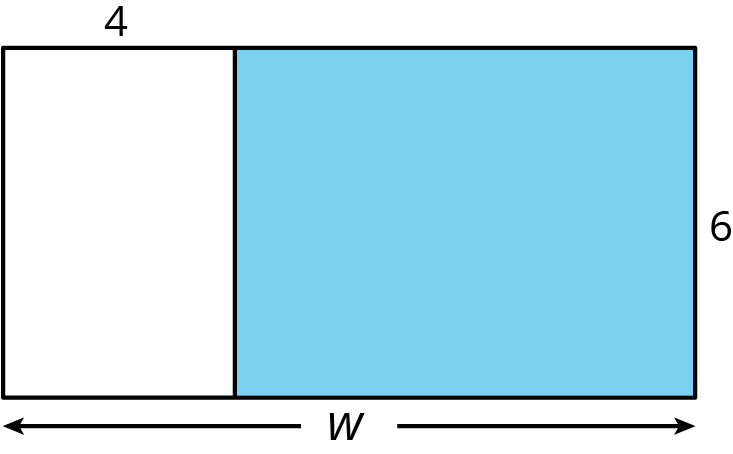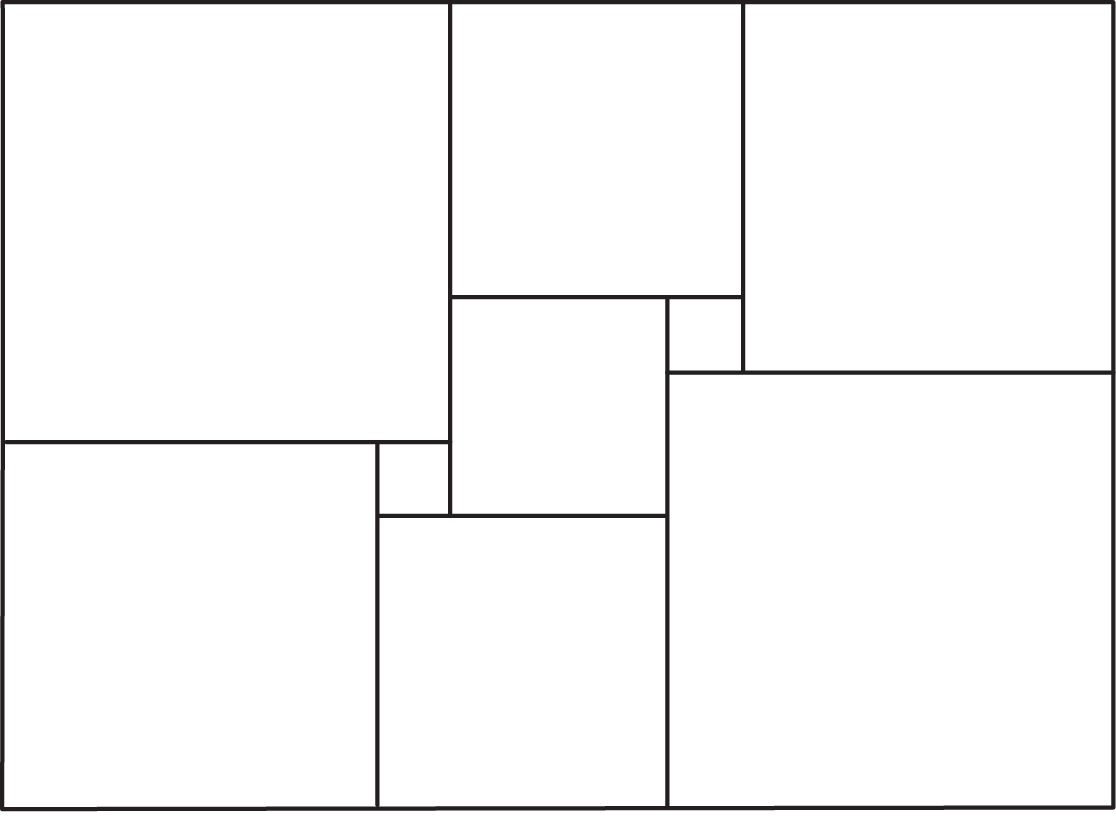Lesson 11
The Distributive Property, Part 3
11.1: The Shaded Region (5 minutes)
Warm-up
Students reflect on equivalent expressions that represent the area of a shaded rectangle which is part of a larger rectangle of unknown width.
Launch
Allow students 2 minutes of quiet work time, followed by a whole-class discussion.
Student Facing
A rectangle with dimensions 6 cm and \(w\) cm is partitioned into two smaller rectangles.
Explain why each of these expressions represents the area, in cm2, of the shaded region.
-
\(6w-24\)
- \(6(w-4)\)

Student Response
For access, consult one of our IM Certified Partners.
Activity Synthesis
Ask students to share their reasoning. \(6w-24\) should be straighforward: the area of the entire rectangle is \(6w\), and the area of the unshaded portion is \(6 \boldcdot 4\) or 24, so the area of the shaded portion is \(6w-24\).
Students may have more trouble with \(6(w-4)\). The key is to understand that the longer side of the shaded portion can be represented by \(w-4\).

11.2: Matching to Practice Distributive Property (15 minutes)
Optional activity
Students practice finding expressions that are equivalent because of the distributive property.
Launch
Allow students 10 minutes of quiet work time, followed by a whole-class discussion.
Supports accessibility for: Social-emotional skills; Conceptual processing
Student Facing
Match each expression in column 1 to an equivalent expression in column 2. If you get stuck, consider drawing a diagram.
Column 1
- \(a(1+2+3)\)
- \(2(12-4)\)
- \(12a+3b\)
- \(\frac23(15a-18)\)
- \(6a+10b\)
- \(0.4(5-2.5a)\)
- \(2a+3a\)
Column 2
- \(3(4a+b)\)
- \(12 \boldcdot 2 - 4 \boldcdot 2\)
- \(2(3a+5b)\)
- \((2+3)a\)
- \(a+2a+3a\)
- \(10a-12\)
- \(2-a\)
Student Response
For access, consult one of our IM Certified Partners.
Activity Synthesis
Invite students to share whether any of the matches were difficult to find and how they worked through the challenge.
Design Principle(s): Maximize meta-awareness
11.3: Writing Equivalent Expressions Using the Distributive Property (15 minutes)
Optional activity
Students practice working back and forth writing equivalent expressions with the distributive property.
Launch
Allow students 10 minutes of quiet work time, followed by a whole-class discussion.
Student Facing
The distributive property can be used to write equivalent expressions. In each row, use the distributive property to write an equivalent expression. If you get stuck, consider drawing a diagram.
| product | sum or difference |
|---|---|
| \(3(3+x)\) | |
| \(4x-20\) | |
| \((9-5)x\) | |
| \(4x+7x\) | |
| \(3(2x+1)\) | |
| \(10x-5\) | |
| \(x+2x+3x\) | |
| \(\frac12 (x-6)\) | |
| \(y(3x+4z)\) | |
| \(2xyz-3yz+4xz\) |
Student Response
For access, consult one of our IM Certified Partners.
Student Facing
Are you ready for more?
This rectangle has been cut up into squares of varying sizes. Both small squares have side length 1 unit. The square in the middle has side length \(x\) units.

- Suppose that \(x\) is 3. Find the area of each square in the diagram. Then find the area of the large rectangle.
- Find the side lengths of the large rectangle assuming that \(x\) is 3. Find the area of the large rectangle by multiplying the length times the width. Check that this is the same area you found before.
- Now suppose that we do not know the value of \(x\). Write an expression for the side lengths of the large rectangle that involves \(x\).
Student Response
For access, consult one of our IM Certified Partners.
Activity Synthesis
Invite students to explain how they knew, when working backwards, what to put in front of the parentheses and what remained inside.
Design Principle(s): Maximize meta-awareness
Lesson Synthesis
Lesson Synthesis
You might want to have students work on a creative visual display for the classroom that shows their understanding of the distributive property in both directions.
11.4: Cool-down - Writing Equivalent Expressions (5 minutes)
Cool-Down
For access, consult one of our IM Certified Partners.
Student Lesson Summary
Student Facing
The distributive property can be used to write a sum as a product, or write a product as a sum. You can always draw a partitioned rectangle to help reason about it, but with enough practice, you should be able to apply the distributive property without making a drawing.
Here are some examples of expressions that are equivalent due to the distributive property.
\(\displaystyle \begin {align} 9+18&=9(1+2)\\ 2(3x+4)&=6x+8\\ 2n+3n+n&=n(2+3+1)\\ 11b-99a&=11(b-9a)\\ k(c+d-e)&=kc+kd-ke\\ \end {align}\)